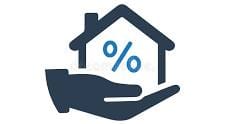Home Loan
Home Loan
Home Loan
Be it buying or renting, a house reflects the prominent personal and financial aspiration in one’s life. Marfo Strategies Private Limited is a step ahead of that very aspiration by offering home loan solutions that meet your unique needs and financial ambition. We recognize the same and work to offer excellence coupled with customer-centricity that has helped us emerge as a frontline player in the home loan services domain.
Our experienced team understands the requirement of each person / individual and works close with bank’s & NBFC to provide the best possible loan options for the client for their specific requirement.
A home loan, or mortgage, is a type of loan given by the lender to assist in purchasing a house. A borrower repays it over a certain period, usually in a time frame of 10 to 30 years, with monthly installments comprising principal and interest. Basically, what is used as collateral when securing the loan is the home, and repayment is normally by down payment and eligibility based on creditworthiness.

Home Purchase Loan
Purpose:
This is a loan that helps one buy a new, or even resale, residential property.Popularity:
his is one of the most common home loans availed by most individuals while purchasing a home / flat / apartment.Key Feature:
Normally, this loan covers 80-90% of the price of an asset; the remaining amount has to be spent out of the pocket by the borrower as the down payment
Home Construction Loan
Purpose:
This type of loan is used to build a house on a piece of land already owned.Popularity:
Products suit best the customer who wants to build a house instead of purchasing a ready one.Key Feature:
Loan disbursement is usually done in parts linked with the progress of construction.
Home Improvement Loan
Purpose:
Renovations, repairs, or improvement of an already existing home.Popularity:
Very popular with the people looking to improve their current places rather than buying a new house.Key Feature:
This loan reimburses expenses incurred toward renovation of the house, like repainting, remodelling, or installing new fittings.
Home Extension Loan
Purpose:
: It is availed to purchase a plot of land on which the borrower intends to construct a house.Popularity:
Very popular amongst people who like to buy the land first and then construct at their own leisure accordingly.Key Feature:
It covers construction expenditure and costs of materials for the extension of the home.
Land Purchase Loan
Purpose:
It is availed to purchase a plot of land on which the borrower intends to construct a house.Popularity:
Very popular amongst people who like to buy the land first and then construct at their own leisure accordingly.Key Feature:
This often requires the borrower to commence construction within a certain timeframe.
Balance Transfer Home Loan
Purpose:
Transfer existing home loan from one lender to another for better terms, say a lower interest rate.Popularity:
Chosen by borrowers looking to reduce their EMIs or shorten their loan tenure.Key Feature:
Enables savings on interest payment and hence can have additional top-up loan options also| ELIGIBILITY CRITERIA | SALARIED INDIVIDUALS | SELF-EMPLOYED INDIVIDUALS |
|---|---|---|
| Age | Typically, 21 to 60 years | Typically, 21 to 65 years |
| Income | Minimum monthly income often required; varies by lender | Minimum annual income often required; varies by lender |
| Employment Stability | At least 2 years of total work experience; usually 1 year with the current employer | At least 2-3 years of business operation or self-employment |
| Credit Score | Generally, a score of 750 and above is preferred | Generally, a score of 750 and above is preferred |
| Employment Type | Permanent or contractual employment | Sole proprietorship, partnership, or private limited company |
| Proof of Income | Salary slips (last 3-6 months), Form 16, bank statements (last 6-12 months) | Income Tax Returns (ITR) for the last 2-3 years, Profit & Loss Account, Balance Sheet, Bank Statements (last 6-12 months) |
| Down Payment | Typically, 10% to 20% of the property value | Typically, 10% to 20% of the property value |
| Property Type | Residential property, ready-to-move or under construction | Residential property, ready-to-move or under construction |
| Existing Liabilities | Consideration of existing loans or debts | Consideration of existing loans or debts |
| Loan Tenure | Usually, 10 to 30 years | Usually, 10 to 30 years |
| Nationality | Indian citizens | Indian citizens and Non-Resident Indians (NRIs) |
| Document Type | Description | Examples |
|---|---|---|
| Identity Proof | Proof of identity of the borrower. | PAN Card, Aadhaar Card, Passport, Voter ID, Driving License |
| Address Proof | Proof of current residential address. | Aadhaar Card, Passport, Voter ID, Driving License, Utility Bills, Rent Agreement, Bank Statement |
| Income Proof | Verification of income for repayment capability. | Salary Slips, Form 16, ITR, Bank Statements (Salaried) |
| ITR, Profit and Loss Account, Balance Sheet, Bank Statements (Self-Employed) | ||
| Employment Proof | Proof of employment or business. | Employment Verification Letter, Proof of Business (Self-Employed) |
| Property Documents | Documentation related to the property being financed. | Sale Deed, Title Deed, Property Tax Receipts, Approved Building Plan, NOC from Builder (if applicable) |
| Photographs | Passport-sized photographs of the borrower and co-borrowers. | – |
| Loan Application Form | Completed and signed application form provided by the lender. | – |
| Additional Documents | Specific documents for NRIs or joint loans. | Proof of NRI Status, Additional KYC Documents, Documents of Co-Borrowers |
| Fee/Charge | Description | Typical Amount/Range |
|---|---|---|
| Processing Fee | Fee charged by the lender for processing the loan application. | 0.5% to 2% of the loan amount |
| Legal Fees | Charges for verifying the legal status of the property. | Varies based on property value and lender |
| Valuation Fees | Fees for property valuation to determine the loan amount. | Varies based on property value and location |
| Documentation Charges | Fees for preparing and managing loan-related documents. | Typically nominal, around ₹500 to ₹2,000 |
| Stamp Duty | Tax paid on the loan agreement and property documents. | Varies by state, typically 4% to 7% of property value |
| Registration Fees | Fees for registering the property with the local authorities. | Varies by state, typically 1% to 2% of property value |
| Prepayment/Foreclosure Charges | Fee charged for repaying the loan before the term ends. | Typically 0% to 2% of the outstanding principal |
| Late Payment Charges | Charges for missed or delayed EMI payments. | 1% to 2% per month on the overdue amount |
| Processing Fee for Top-Up Loan | Fee for applying for an additional loan amount on an existing loan. | Similar to initial processing fee |
| Overdue Interest Charges | Additional interest for overdue payments. | Varies, often higher than regular EMI interest |

Fill the form
Fill out the application form. It takes only 3 minutes!
Answer your phone
Have a quick chat with our representative to learn about your Home Loan
Get a Loan From best lender
Sit back and relax! You are on your way to secure a Home loan.Be it buying or renting, a house reflects the prominent personal and financial aspiration in one’s life. Marfo Strategies Private Limited is a step ahead of that very aspiration by offering home loan solutions that meet your unique needs and financial ambition. We recognize the same and work to offer excellence coupled with customer-centricity that has helped us emerge as a frontline player in the home loan services domain.
Our experienced team understands the requirement of each person / individual and works close with bank’s & NBFC to provide the best possible loan options for the client for their specific requirement.
A home loan, or mortgage, is a type of loan given by the lender to assist in purchasing a house. A borrower repays it over a certain period, usually in a time frame of 10 to 30 years, with monthly installments comprising principal and interest. Basically, what is used as collateral when securing the loan is the home, and repayment is normally by down payment and eligibility based on creditworthiness.

Home Purchase Loan
Purpose:
This is a loan that helps one buy a new, or even resale, residential property.Popularity:
his is one of the most common home loans availed by most individuals while purchasing a home / flat / apartment.Key Feature:
Normally, this loan covers 80-90% of the price of an asset; the remaining amount has to be spent out of the pocket by the borrower as the down payment
Home Construction Loan
Purpose:
This type of loan is used to build a house on a piece of land already owned.Popularity:
Products suit best the customer who wants to build a house instead of purchasing a ready one.Key Feature:
Loan disbursement is usually done in parts linked with the progress of construction.
Home Improvement Loan
Purpose:
Renovations, repairs, or improvement of an already existing home.Popularity:
Very popular with the people looking to improve their current places rather than buying a new house.Key Feature:
This loan reimburses expenses incurred toward renovation of the house, like repainting, remodelling, or installing new fittings.
Home Extension Loan
Purpose:
: It is availed to purchase a plot of land on which the borrower intends to construct a house.Popularity:
Very popular amongst people who like to buy the land first and then construct at their own leisure accordingly.Key Feature:
It covers construction expenditure and costs of materials for the extension of the home.
Land Purchase Loan
Purpose:
It is availed to purchase a plot of land on which the borrower intends to construct a house.Popularity:
Very popular amongst people who like to buy the land first and then construct at their own leisure accordingly.Key Feature:
This often requires the borrower to commence construction within a certain timeframe.
Balance Transfer Home Loan
Purpose:
Transfer existing home loan from one lender to another for better terms, say a lower interest rate.Popularity:
Chosen by borrowers looking to reduce their EMIs or shorten their loan tenure.Key Feature:
Enables savings on interest payment and hence can have additional top-up loan options also| ELIGIBILITY CRITERIA | SALARIED INDIVIDUALS | SELF-EMPLOYED INDIVIDUALS |
|---|---|---|
| Age | Typically, 21 to 60 years | Typically, 21 to 65 years |
| Income | Minimum monthly income often required; varies by lender | Minimum annual income often required; varies by lender |
| Employment Stability | At least 2 years of total work experience; usually 1 year with the current employer | At least 2-3 years of business operation or self-employment |
| Credit Score | Generally, a score of 750 and above is preferred | Generally, a score of 750 and above is preferred |
| Employment Type | Permanent or contractual employment | Sole proprietorship, partnership, or private limited company |
| Proof of Income | Salary slips (last 3-6 months), Form 16, bank statements (last 6-12 months) | Income Tax Returns (ITR) for the last 2-3 years, Profit & Loss Account, Balance Sheet, Bank Statements (last 6-12 months) |
| Down Payment | Typically, 10% to 20% of the property value | Typically, 10% to 20% of the property value |
| Property Type | Residential property, ready-to-move or under construction | Residential property, ready-to-move or under construction |
| Existing Liabilities | Consideration of existing loans or debts | Consideration of existing loans or debts |
| Loan Tenure | Usually, 10 to 30 years | Usually, 10 to 30 years |
| Nationality | Indian citizens | Indian citizens and Non-Resident Indians (NRIs) |
| Document Type | Description | Examples |
|---|---|---|
| Identity Proof | Proof of identity of the borrower. | PAN Card, Aadhaar Card, Passport, Voter ID, Driving License |
| Address Proof | Proof of current residential address. | Aadhaar Card, Passport, Voter ID, Driving License, Utility Bills, Rent Agreement, Bank Statement |
| Income Proof | Verification of income for repayment capability. | Salary Slips, Form 16, ITR, Bank Statements (Salaried) |
| ITR, Profit and Loss Account, Balance Sheet, Bank Statements (Self-Employed) | ||
| Employment Proof | Proof of employment or business. | Employment Verification Letter, Proof of Business (Self-Employed) |
| Property Documents | Documentation related to the property being financed. | Sale Deed, Title Deed, Property Tax Receipts, Approved Building Plan, NOC from Builder (if applicable) |
| Photographs | Passport-sized photographs of the borrower and co-borrowers. | – |
| Loan Application Form | Completed and signed application form provided by the lender. | – |
| Additional Documents | Specific documents for NRIs or joint loans. | Proof of NRI Status, Additional KYC Documents, Documents of Co-Borrowers |
| Fee/Charge | Description | Typical Amount/Range |
|---|---|---|
| Processing Fee | Fee charged by the lender for processing the loan application. | 0.5% to 2% of the loan amount |
| Legal Fees | Charges for verifying the legal status of the property. | Varies based on property value and lender |
| Valuation Fees | Fees for property valuation to determine the loan amount. | Varies based on property value and location |
| Documentation Charges | Fees for preparing and managing loan-related documents. | Typically nominal, around ₹500 to ₹2,000 |
| Stamp Duty | Tax paid on the loan agreement and property documents. | Varies by state, typically 4% to 7% of property value |
| Registration Fees | Fees for registering the property with the local authorities. | Varies by state, typically 1% to 2% of property value |
| Prepayment/Foreclosure Charges | Fee charged for repaying the loan before the term ends. | Typically 0% to 2% of the outstanding principal |
| Late Payment Charges | Charges for missed or delayed EMI payments. | 1% to 2% per month on the overdue amount |
| Processing Fee for Top-Up Loan | Fee for applying for an additional loan amount on an existing loan. | Similar to initial processing fee |
| Overdue Interest Charges | Additional interest for overdue payments. | Varies, often higher than regular EMI interest |

Fill the form
Fill out the application form. It takes only 3 minutes!
Answer your phone
Have a quick chat with our representative to learn about your Home Loan
Get a Loan From best lender
Sit back and relax! You are on your way to secure a Home loan.Be it buying or renting, a house reflects the prominent personal and financial aspiration in one’s life. Marfo Strategies Private Limited is a step ahead of that very aspiration by offering home loan solutions that meet your unique needs and financial ambition. We recognize the same and work to offer excellence coupled with customer-centricity that has helped us emerge as a frontline player in the home loan services domain.
Our experienced team understands the requirement of each person / individual and works close with bank’s & NBFC to provide the best possible loan options for the client for their specific requirement.
A home loan, or mortgage, is a type of loan given by the lender to assist in purchasing a house. A borrower repays it over a certain period, usually in a time frame of 10 to 30 years, with monthly installments comprising principal and interest. Basically, what is used as collateral when securing the loan is the home, and repayment is normally by down payment and eligibility based on creditworthiness.

Home Purchase Loan
Purpose:
This is a loan that helps one buy a new, or even resale, residential property.Popularity:
his is one of the most common home loans availed by most individuals while purchasing a home / flat / apartment.Key Feature:
Normally, this loan covers 80-90% of the price of an asset; the remaining amount has to be spent out of the pocket by the borrower as the down payment
Home Construction Loan
Purpose:
This type of loan is used to build a house on a piece of land already owned.Popularity:
Products suit best the customer who wants to build a house instead of purchasing a ready one.Key Feature:
Loan disbursement is usually done in parts linked with the progress of construction.
Home Improvement Loan
Purpose:
Renovations, repairs, or improvement of an already existing home.Popularity:
Very popular with the people looking to improve their current places rather than buying a new house.Key Feature:
This loan reimburses expenses incurred toward renovation of the house, like repainting, remodelling, or installing new fittings.
Home Extension Loan
Purpose:
: It is availed to purchase a plot of land on which the borrower intends to construct a house.Popularity:
Very popular amongst people who like to buy the land first and then construct at their own leisure accordingly.Key Feature:
It covers construction expenditure and costs of materials for the extension of the home.
Land Purchase Loan
Purpose:
It is availed to purchase a plot of land on which the borrower intends to construct a house.Popularity:
Very popular amongst people who like to buy the land first and then construct at their own leisure accordingly.Key Feature:
This often requires the borrower to commence construction within a certain timeframe.
Balance Transfer Home Loan
Purpose:
Transfer existing home loan from one lender to another for better terms, say a lower interest rate.Popularity:
Chosen by borrowers looking to reduce their EMIs or shorten their loan tenure.Key Feature:
Enables savings on interest payment and hence can have additional top-up loan options also| ELIGIBILITY CRITERIA | SALARIED INDIVIDUALS | SELF-EMPLOYED INDIVIDUALS |
|---|---|---|
| Age | Typically, 21 to 60 years | Typically, 21 to 65 years |
| Income | Minimum monthly income often required; varies by lender | Minimum annual income often required; varies by lender |
| Employment Stability | At least 2 years of total work experience; usually 1 year with the current employer | At least 2-3 years of business operation or self-employment |
| Credit Score | Generally, a score of 750 and above is preferred | Generally, a score of 750 and above is preferred |
| Employment Type | Permanent or contractual employment | Sole proprietorship, partnership, or private limited company |
| Proof of Income | Salary slips (last 3-6 months), Form 16, bank statements (last 6-12 months) | Income Tax Returns (ITR) for the last 2-3 years, Profit & Loss Account, Balance Sheet, Bank Statements (last 6-12 months) |
| Down Payment | Typically, 10% to 20% of the property value | Typically, 10% to 20% of the property value |
| Property Type | Residential property, ready-to-move or under construction | Residential property, ready-to-move or under construction |
| Existing Liabilities | Consideration of existing loans or debts | Consideration of existing loans or debts |
| Loan Tenure | Usually, 10 to 30 years | Usually, 10 to 30 years |
| Nationality | Indian citizens | Indian citizens and Non-Resident Indians (NRIs) |
| Document Type | Description | Examples |
|---|---|---|
| Identity Proof | Proof of identity of the borrower. | PAN Card, Aadhaar Card, Passport, Voter ID, Driving License |
| Address Proof | Proof of current residential address. | Aadhaar Card, Passport, Voter ID, Driving License, Utility Bills, Rent Agreement, Bank Statement |
| Income Proof | Verification of income for repayment capability. | Salary Slips, Form 16, ITR, Bank Statements (Salaried) |
| ITR, Profit and Loss Account, Balance Sheet, Bank Statements (Self-Employed) | ||
| Employment Proof | Proof of employment or business. | Employment Verification Letter, Proof of Business (Self-Employed) |
| Property Documents | Documentation related to the property being financed. | Sale Deed, Title Deed, Property Tax Receipts, Approved Building Plan, NOC from Builder (if applicable) |
| Photographs | Passport-sized photographs of the borrower and co-borrowers. | – |
| Loan Application Form | Completed and signed application form provided by the lender. | – |
| Additional Documents | Specific documents for NRIs or joint loans. | Proof of NRI Status, Additional KYC Documents, Documents of Co-Borrowers |
| Fee/Charge | Description | Typical Amount/Range |
|---|---|---|
| Processing Fee | Fee charged by the lender for processing the loan application. | 0.5% to 2% of the loan amount |
| Legal Fees | Charges for verifying the legal status of the property. | Varies based on property value and lender |
| Valuation Fees | Fees for property valuation to determine the loan amount. | Varies based on property value and location |
| Documentation Charges | Fees for preparing and managing loan-related documents. | Typically nominal, around ₹500 to ₹2,000 |
| Stamp Duty | Tax paid on the loan agreement and property documents. | Varies by state, typically 4% to 7% of property value |
| Registration Fees | Fees for registering the property with the local authorities. | Varies by state, typically 1% to 2% of property value |
| Prepayment/Foreclosure Charges | Fee charged for repaying the loan before the term ends. | Typically 0% to 2% of the outstanding principal |
| Late Payment Charges | Charges for missed or delayed EMI payments. | 1% to 2% per month on the overdue amount |
| Processing Fee for Top-Up Loan | Fee for applying for an additional loan amount on an existing loan. | Similar to initial processing fee |
| Overdue Interest Charges | Additional interest for overdue payments. | Varies, often higher than regular EMI interest |

Fill the form
Fill out the application form. It takes only 3 minutes!
Answer your phone
Have a quick chat with our representative to learn about your Home Loan
Get a Loan From best lender
Sit back and relax! You are on your way to secure a Home loan.EMI Calculator
0 INR
0 INR
EMI Calculator
0 INR
0 INR
EMI Calculator
0 INR
0 INR
Home Loan FAQs
A home loan is a kind of secured loan that financial institutions make available to a person for buying, constructing, or renovating a residential property. The residential property serves as collateral for the loan.
On the other hand, the criteria for eligibility to qualify for a home loan are based upon age, income, continuity of job, credit score, and property value. A salaried or self-employed person with good credit history and regular income should be able to get a home loan.
The loan amount depends on the value of the property, your income, and the lender’s policies. Typically, lenders finance up to 75% to 90% of the property value, with the remaining amount being covered by your own funds.
Rates of interest for home loans vary from lender to lender, keeping in view the loan amount, tenure, and credit profile of the borrower. Basically, this varies between 6.5% per annum and 8.5% per annum.
The tenure for a home loan could be for a minimum of 10 to a maximum of 30 years, depending upon the choice and eligibility of the borrower. The longer the tenure, the smaller would be the monthly EMI to be paid; however, this increases the overall interest burden.
Yes, the property you are purchasing or renovating acts as collateral for the home loan. The title deed of the property is held by the lender until the loan is fully repaid.
Home loan approval may take a few days or even weeks, again depending on how complete the documentation is and how fast the lender processes. Pre-approval may hasten the process.
Documents usually required are identity proof, residence proof, income proof, including salary slips and IT returns, bank statements, property documents that include title deed and sale agreement, and recent photographs. Any other additional documents, if applicable, would be to the lender's discretion.
Basically, yes, most of the lenders do either allow prepayment or foreclosure of the loan taken against your home. A few of them charge a prepayment penalty, especially in the case of fixed rate loans. So, better find out from your lender about this term.
A fixed-rate home loan is a kind of loan where interest remains unchanged throughout the loan tenure, hence maintaining consistency in monthly repayments. A floating-rate home loan is a type of loan where interest can change with respect to market fluctuations, due to which the EMI amount may change over a period of time.
Yes, home loans can be utilised even for buying a second home or an investment property. It may be that the eligibility criterion and loan term vary, yet lenders generally offer financing on more properties, provided the borrower meets the requirements.
Yes, home loans could be acquired for the purpose of renovating or improving a property. A couple of lenders have specialized home renovation loans, while you could also be in a position to extend your existing home loan to cover the costs.
Yes, most lenders provide home loans to purchase land and build a house. The amount is usually dispersed in instalments which depends upon the progress of the construction work.
It is quite frequent to take a home loan for an under-construction property as there is some risk involved, and one of the most common things that happen is construction delays. It will be important to research whether the builder is good and whether the property has all approvals.
Yes, you can transfer your home loan to another lender through a process called a balance transfer or, in general, refinancing of your home loan. This may be beneficial in case the new lender offers better interest rates or more attractive terms.
Home Loan FAQs
A home loan is a kind of secured loan that financial institutions make available to a person for buying, constructing, or renovating a residential property. The residential property serves as collateral for the loan.
On the other hand, the criteria for eligibility to qualify for a home loan are based upon age, income, continuity of job, credit score, and property value. A salaried or self-employed person with good credit history and regular income should be able to get a home loan.
The loan amount depends on the value of the property, your income, and the lender’s policies. Typically, lenders finance up to 75% to 90% of the property value, with the remaining amount being covered by your own funds.
Rates of interest for home loans vary from lender to lender, keeping in view the loan amount, tenure, and credit profile of the borrower. Basically, this varies between 6.5% per annum and 8.5% per annum.
The tenure for a home loan could be for a minimum of 10 to a maximum of 30 years, depending upon the choice and eligibility of the borrower. The longer the tenure, the smaller would be the monthly EMI to be paid; however, this increases the overall interest burden.
Yes, the property you are purchasing or renovating acts as collateral for the home loan. The title deed of the property is held by the lender until the loan is fully repaid.
Home loan approval may take a few days or even weeks, again depending on how complete the documentation is and how fast the lender processes. Pre-approval may hasten the process.
Documents usually required are identity proof, residence proof, income proof, including salary slips and IT returns, bank statements, property documents that include title deed and sale agreement, and recent photographs. Any other additional documents, if applicable, would be to the lender's discretion.
Basically, yes, most of the lenders do either allow prepayment or foreclosure of the loan taken against your home. A few of them charge a prepayment penalty, especially in the case of fixed rate loans. So, better find out from your lender about this term.
A fixed-rate home loan is a kind of loan where interest remains unchanged throughout the loan tenure, hence maintaining consistency in monthly repayments. A floating-rate home loan is a type of loan where interest can change with respect to market fluctuations, due to which the EMI amount may change over a period of time.
Yes, home loans can be utilised even for buying a second home or an investment property. It may be that the eligibility criterion and loan term vary, yet lenders generally offer financing on more properties, provided the borrower meets the requirements.
Yes, home loans could be acquired for the purpose of renovating or improving a property. A couple of lenders have specialized home renovation loans, while you could also be in a position to extend your existing home loan to cover the costs.
Yes, most lenders provide home loans to purchase land and build a house. The amount is usually dispersed in instalments which depends upon the progress of the construction work.
It is quite frequent to take a home loan for an under-construction property as there is some risk involved, and one of the most common things that happen is construction delays. It will be important to research whether the builder is good and whether the property has all approvals.
Yes, you can transfer your home loan to another lender through a process called a balance transfer or, in general, refinancing of your home loan. This may be beneficial in case the new lender offers better interest rates or more attractive terms.
Home Loan FAQs
A home loan is a kind of secured loan that financial institutions make available to a person for buying, constructing, or renovating a residential property. The residential property serves as collateral for the loan.
On the other hand, the criteria for eligibility to qualify for a home loan are based upon age, income, continuity of job, credit score, and property value. A salaried or self-employed person with good credit history and regular income should be able to get a home loan.
The loan amount depends on the value of the property, your income, and the lender’s policies. Typically, lenders finance up to 75% to 90% of the property value, with the remaining amount being covered by your own funds.
Rates of interest for home loans vary from lender to lender, keeping in view the loan amount, tenure, and credit profile of the borrower. Basically, this varies between 6.5% per annum and 8.5% per annum.
The tenure for a home loan could be for a minimum of 10 to a maximum of 30 years, depending upon the choice and eligibility of the borrower. The longer the tenure, the smaller would be the monthly EMI to be paid; however, this increases the overall interest burden.
Yes, the property you are purchasing or renovating acts as collateral for the home loan. The title deed of the property is held by the lender until the loan is fully repaid.
Home loan approval may take a few days or even weeks, again depending on how complete the documentation is and how fast the lender processes. Pre-approval may hasten the process.
Documents usually required are identity proof, residence proof, income proof, including salary slips and IT returns, bank statements, property documents that include title deed and sale agreement, and recent photographs. Any other additional documents, if applicable, would be to the lender's discretion.
Basically, yes, most of the lenders do either allow prepayment or foreclosure of the loan taken against your home. A few of them charge a prepayment penalty, especially in the case of fixed rate loans. So, better find out from your lender about this term.
A fixed-rate home loan is a kind of loan where interest remains unchanged throughout the loan tenure, hence maintaining consistency in monthly repayments. A floating-rate home loan is a type of loan where interest can change with respect to market fluctuations, due to which the EMI amount may change over a period of time.
Yes, home loans can be utilised even for buying a second home or an investment property. It may be that the eligibility criterion and loan term vary, yet lenders generally offer financing on more properties, provided the borrower meets the requirements.
Yes, home loans could be acquired for the purpose of renovating or improving a property. A couple of lenders have specialized home renovation loans, while you could also be in a position to extend your existing home loan to cover the costs.
Yes, most lenders provide home loans to purchase land and build a house. The amount is usually dispersed in instalments which depends upon the progress of the construction work.
It is quite frequent to take a home loan for an under-construction property as there is some risk involved, and one of the most common things that happen is construction delays. It will be important to research whether the builder is good and whether the property has all approvals.
Yes, you can transfer your home loan to another lender through a process called a balance transfer or, in general, refinancing of your home loan. This may be beneficial in case the new lender offers better interest rates or more attractive terms.


